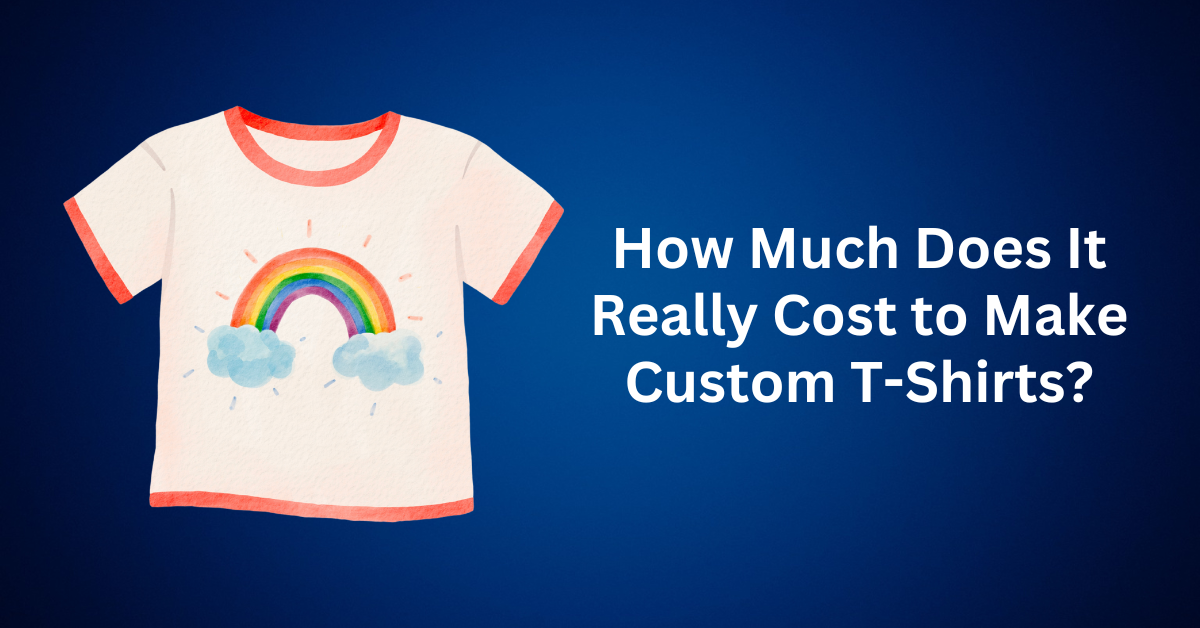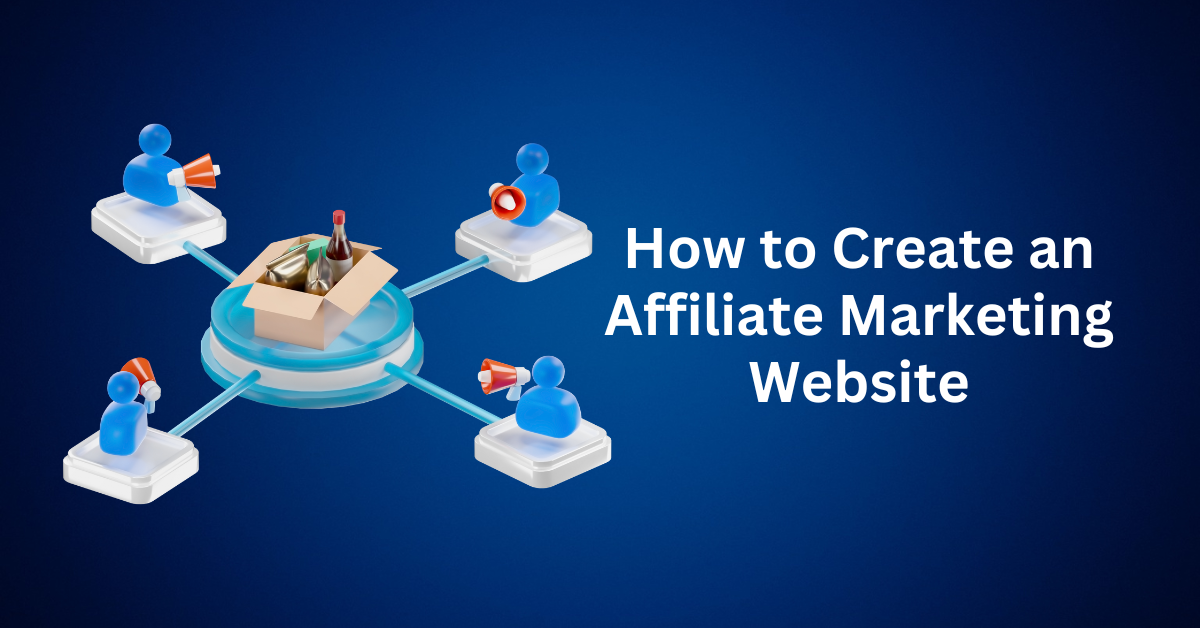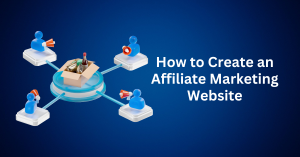If you’re thinking about starting custom t-shirts business, one of the first questions that comes to mind is: “How much does it actually cost to make a shirt?”
It’s a fair question, and the answer isn’t as simple as a single number. You’ll need to cover the basics, including fabric, printing, and design. But the real cost of making a t-shirt goes deeper than that. Platform fees, taxes, packaging, shipping, and even marketing all influence how much profit you actually take home.
Whether you’re testing a few shirts to gauge interest or planning to scale a full print-on-demand store, understanding your true shirt cost is crucial before you launch. Let’s break down every expense that goes into creating custom T-shirts, from raw materials to packaging, so you can price your products with confidence.
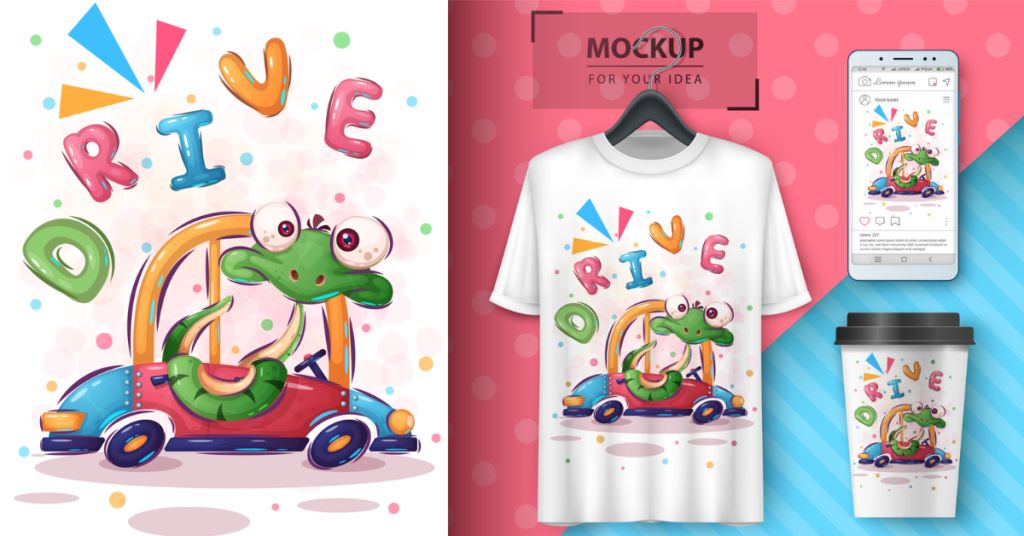
Table of Contents
ToggleUnderstanding Custom T-Shirts Production Costs
There’s no one-size-fits-all answer when it comes to custom t-shirts production costs. Every shirt you sell is influenced by several variables: the type of fabric, the printing method, design complexity, packaging, and even your supplier’s location.
To help you estimate your cost per shirt, here’s a complete breakdown of the key factors that impact your bottom line.
1. Base Materials: Choosing the Right Fabric
The fabric you choose forms the foundation of your custom t-shirt’s cost, and it also determines how your final product feels, fits, and looks.
- Basic cotton t-shirts – Affordable, widely available, and perfect for promotional shirts or casual wear. These are ideal for testing your store idea or offering budget-friendly designs.
- Premium cotton (Combed or Ringspun) – Softer, smoother, and more durable, allowing you to sell at a higher retail price.
- Tri-blend (Cotton, Polyester, Rayon) – Popular for lifestyle brands and premium merch. The combination adds softness and flexibility but costs slightly more.
- Luxury fabrics (Pima or Egyptian cotton) – Deliver an upscale feel and long-lasting quality, ideal for boutique brands. However, expect a higher production cost.
Pro Tip: Lighter, smoother fabrics produce sharper, more vibrant prints with digital printing. Heavier cotton may absorb ink differently and slightly alter the final look.
Bottom line: Your fabric choice influences not just comfort and appearance but also how much your customers are willing to pay.
2. Printing Methods: How You Bring Your Design to Life
The printing technique you choose plays a massive role in both the visual outcome and your cost per unit. Here’s a quick look at the most common t-shirt printing methods and their pros and cons:
- Direct-to-Garment (DTG) – Best for short runs or designs with lots of colors and details. There’s no setup fee, but the per-shirt cost is higher than bulk printing.
- Screen Printing (Silk Screen) – Ideal for large orders. Each color requires its own screen, which means setup takes longer, but your unit cost drops significantly at higher volumes.
- Heat Transfer (Vinyl or DTF) – Flexible for small or urgent orders. Produces good quality but tends to wear faster after multiple washes.
- Embroidery – Adds a textured, professional look. Perfect for logos or uniforms. It’s also the most expensive method due to stitching time and materials.
- All-Over Sublimation Printing – Covers the entire garment from edge to edge. Great for bold, creative designs, but slightly pricier and slower to produce.
- Specialty Printing (Puff, Metallic, Foil, etc.) – Adds texture, shine, or raised effects. These premium finishes can increase costs but help your brand stand out.
Key takeaway: For beginners, DTG or heat transfer is great for flexibility. Once your designs start selling consistently, switching to bulk screen printing can drastically lower your per-shirt cost.
3. Design Costs: The Often Overlooked Expense
A great design can make or break your t-shirt business. You could use the best-quality fabric available, but if the design looks amateurish or uninspired, customers simply won’t buy it. Your design isn’t just decoration. Instead, it’s the core of your brand identity and what makes your shirts stand out in a crowded market.
When it comes to cost, your design choices play a big role. Hiring a professional designer gives your shirts a polished, brand-ready look but increases your upfront investment. If you prefer to design on your own, using tools like Canva or free templates can keep expenses down, though it often means sacrificing some originality. For those with a bit of design experience, using professional software such as Adobe Illustrator or Photoshop offers a good middle ground. It provides full creative control without the recurring cost of outsourcing.
It’s also easy to overlook the smaller design-related expenses that can quietly eat into your profits. Things like licensed fonts, paid stock images, mockup templates, and subscription fees for design software might not seem like much individually, but together, they can add up quickly. Make sure to include them in your pricing strategy so you’re not cutting into your margins unknowingly.
The bottom line? Treat design as an investment, not just a cost. A strong, memorable design can help you charge a premium price, attract loyal customers, and build a recognizable brand that stands the test of time.
4. Packaging: The Final Touch That Builds Your Brand
Packaging isn’t just about keeping your shirts safe during shipping. It’s an extension of your brand and a key part of the customer experience. The way your product arrives can make a lasting impression and even turn a one-time buyer into a loyal fan.
You have a few main options when it comes to packaging. The most basic choice is standard poly mailers or envelopes. They’re simple, affordable, and get the job done, making them ideal when you’re just starting. On the other hand, branded packaging like custom boxes, eco-friendly mailers, tissue paper, or personalized thank-you cards adds a premium touch. While it costs more, it reinforces your brand’s identity and creates a memorable unboxing experience. You can also include small extras, such as stickers, discount coupons, or care instruction cards, to make the package feel more thoughtful and engaging.
If you’re working with print-on-demand platforms like Printify or Printful, you’ll usually have the option to choose between standard and branded packaging directly through your supplier. This makes it easier to scale your presentation as your business grows.
A smart approach is to start simple to keep costs under control, then gradually introduce custom packaging for your higher-margin or premium collections. This strategy allows you to enhance your brand image over time without cutting too deeply into your profits.
Other Hidden Costs That Affect Your Custom T-Shirts Pricing
When it comes to running a profitable t-shirt business, the real costs go far beyond fabric and printing. Every seller, whether running a print-on-demand store or managing inventory, must consider shipping fees, platform charges, marketing expenses, and returns. These additional costs often determine whether your business thrives with solid profit margins or barely breaks even.
Let’s look at each of these in detail so you can price your shirts strategically and protect your bottom line.
1. Shipping Costs: The Invisible Profit Killer
No matter how efficient your production process is, every custom t-shirt still needs to reach the customer. However, shipping costs can quietly eat into your profits if you don’t plan for them carefully.
While most print-on-demand platforms and suppliers offer standard shipping rates, the real cost often varies based on several factors. For example, delivery speed (standard versus express), destination (domestic or international), and packaging type (basic or branded) all influence the cost.
In particular, international shipping tends to be the most unpredictable. Currency fluctuations, customs fees, and sudden changes in the supply chain can all introduce unexpected expenses. As a result, a $10 shirt might look like a solid deal until you realize that shipping costs have quietly eaten up most of your profit margin.
Because of this, many savvy sellers choose to build shipping fees directly into their product prices and promote “Free Shipping.” Even though customers are technically paying for shipping within the total price, the psychological impact of seeing “free shipping” often boosts conversions and overall customer satisfaction.
That said, if you decide to offer free shipping, be sure to factor those costs into your base price beforehand. This strategy helps you maintain healthy profit margins while positioning your brand as friendlier and more transparent than competitors who tack on extra fees at checkout.
2. Platform Fees: The Cost of Doing Business Online
Every eCommerce platform comes with its own set of fees; it’s simply part of doing business online. Whether you’re selling on Shopify, Etsy, WooCommerce, or any other marketplace, you’ll need to budget for costs like listing fees, transaction fees, and payment processing charges. Ignoring these expenses can be a costly mistake. Even if your prices seem competitive, you might actually be losing money with every sale once those hidden costs are deducted.
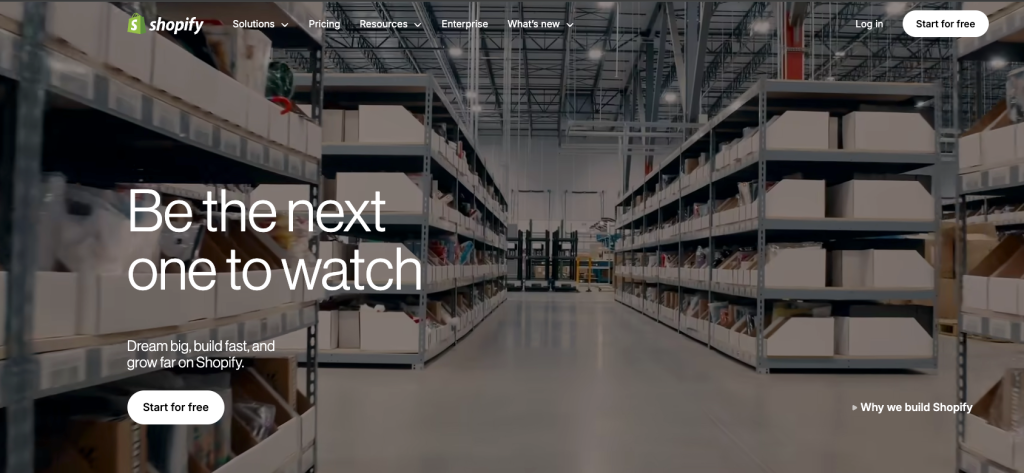
There are a few key fees to keep in mind. Listing or subscription fees cover the cost of hosting your products on the platform, which might come as a monthly charge or a small fee per item. Then there are transaction fees, usually ranging between 2% and 6%, which are taken from each sale. On top of that, payment processors such as Stripe or PayPal charge around 2.9% plus a small fixed amount for every transaction.
These numbers may look small, but they add up fast. The best approach is to include all these expenses in your product’s base price so that your profit margin stays intact. For example, if your platform takes a 5% fee and you sell a shirt for $25, that’s $1.25 per sale going to fees. Multiply that by 500 shirts in a month, and you’ve just lost $625. The money that could have been profit if your pricing had been adjusted properly.
In short, smart pricing isn’t just about staying competitive; it’s about protecting your bottom line. Always account for platform fees so your business remains sustainable and profitable as it grows.
3. Marketing Expenses: The Engine That Drives Sales
You can have the most stunning designs and the best-quality shirts, but without effective marketing, no one will know they exist. Marketing is often where new sellers stumble. They underestimate the costs involved and end up with thin profit margins or missed sales opportunities. The truth is, your marketing efforts determine how quickly your brand grows and how well it connects with customers.
Your marketing budget can go in several directions. Paid ads on platforms like Facebook, Instagram, TikTok, and Google are the fastest way to generate traffic and sales, but they can also be the most expensive. Collaborating with influencers can be another powerful strategy, offering social proof and exposure, though you’ll often need to send free products or pay a fee. For long-term growth, SEO and content marketing, such as writing blog posts, optimizing your product listings, or creating YouTube and Pinterest content, can steadily attract organic traffic. It’s a cost-effective option, but it requires time, patience, and consistency.
Don’t forget about email marketing tools like Mailchimp, Klaviyo, or GetResponse, which help you nurture leads and turn one-time buyers into repeat customers. These platforms usually charge monthly based on the size of your contact list, so the cost grows as your audience expands.
While marketing does add to your overall cost per sale, it also increases your brand’s perceived value. Customers are far more likely to pay a premium for a brand that looks polished, trustworthy, and active online. A good rule of thumb is to allocate around 10–20% of your product price toward marketing. This ensures you always have a steady budget for promotions, without eating into your profits.
4. Returns and Refunds: The Silent Profit Drain
Even with the best-quality shirts and excellent customer service, returns are a part of doing business in eCommerce. If you don’t plan for them, they can quietly eat into your profits before you even notice.
Most print-on-demand platforms, including Printify, manage returns through their individual print providers. However, it’s up to you to decide how your store handles them. Your return policy isn’t just a set of rules. It directly affects your brand’s reputation and your bottom line.
Start by setting a clear return policy. Decide whether you’ll offer refunds, replacements, or store credit, and make those terms easy for customers to understand. Then, look at the numbers. Returns still cost you in printing, packaging, and sometimes shipping, even if you don’t lose the entire sale.
Handled right, returns can actually work in your favor. A fair and transparent policy builds trust and encourages repeat purchases. To protect your profit margin, include a small return allowance in your pricing, typically around 2–5% of total sales. That way, when returns do happen (and they will), your business stays steady and your customers stay confident.
Why Choose Print on Demand for Custom T-Shirts (And What It Really Costs)
If you’ve ever wondered how much it costs to make a t-shirt, the answer depends on how you produce it. There are three main methods most sellers use: DIY printing, bulk inventory, and Print on Demand (POD).
Each approach comes with its own balance of cost, effort, and risk, but for most modern entrepreneurs, Print on Demand has become the smartest, most flexible way to launch and grow a t-shirt brand online.
Let’s break down what each method costs and why POD stands out as the clear winner for most sellers.
T-Shirt Production Cost Comparison
| Method | Average Cost per Shirt | Upfront Investment | Minimum Order | Best For |
| Print on Demand (POD) | $9–$14 (includes shirt printing, fulfillment & packaging) | $0 (no setup costs) | 1 | New sellers, test launches, low-risk scaling |
| Bulk Ordering | $4–$7 (base cost drops with volume discounts) | $500–$1,000+ (for stock & manufacturing) | 25–100+ | Established brands, retail stores, wholesale |
| DIY (Do It Yourself) | $2–$5 (materials) + $3–$6 (printing methods like vinyl or screen kits) | $1,000–$3,000+ (equipment & setup) | N/A (limited by your own capacity) | Hobbyists, crafters, or small custom projects |
Why Print on Demand Beats the Alternatives for Custom T-Shirts
Print on Demand isn’t just convenient. It’s a low-risk, high-flexibility business model designed for today’s eCommerce world. Instead of investing thousands upfront in equipment or stock, you only pay when a customer buys. Let’s look at why more t-shirt entrepreneurs are switching to POD.
1. Zero Upfront Investment
Unlike bulk orders or DIY setups that require a large cash outlay, Print on Demand eliminates upfront costs.
You don’t have to buy inventory, rent storage, or purchase machinery. Every shirt is printed, packed, and shipped only after a sale.
This “sell first, produce later” model minimizes financial risk, perfect for beginners or side hustlers testing the waters.
2. Full Flexibility for Testing and Creativity
Want to test a new design or drop a limited edition without worrying about overstock? That’s exactly where print-on-demand shines. With POD, you can upload fresh designs, launch new products, and remove low-performing ones whenever you like, all without holding any physical inventory.
This kind of flexibility opens up endless possibilities. You can experiment with different niches or creative themes to see what your audience responds to. You can A/B test artwork, colors, and slogans without spending money on bulk production. And when a trend or season comes around, you can release themed designs confidently, knowing you won’t be stuck with leftovers later.
For creators who value freedom, agility, and low risk, POD is the perfect setup. It lets you move fast, stay creative, and keep your business lean.
3. Scalable Without Extra Work
With traditional printing, scaling your business usually means taking on more work. Bigger orders, more staff, and complex logistics to manage. But with print-on-demand, growth looks completely different. Scaling happens automatically.
Whether you sell one shirt or a thousand, your POD provider takes care of everything behind the scenes: printing and quality control, packaging and labeling, even global shipping and tracking.
That leaves you free to focus on what really matters. Marketing, sales, and building your brand while your production quietly runs in the background.
4. Transparent and Predictable Costs
Print-on-demand platforms like Printify and Printful make pricing simple and transparent. Their all-in-one rates cover everything from shirt printing and fulfillment to packaging, so no hidden fees or surprise costs are waiting at the end of the month.
This clarity gives you full control over your business. You can set consistent profit margins, confidently offer “free shipping” without worrying about cutting into profits, and predict your monthly expenses with precision.
When you know your exact cost per shirt, you can make smarter pricing decisions, plan your promotions effectively, and scale your business with confidence.
5. Endless Design Freedom
Print-on-demand technology has come a long way from the days of basic logo tees. Today, you can create products that look and feel truly premium. Think all-over prints that cover the entire garment, detailed embroidery for a professional touch, or high-quality DTG and DTF prints that capture every intricate detail of your design. You can even experiment with special finishes like metallic, puff, or gradient effects to make your products stand out.
The best part? You can do all of this without investing in expensive printing machines or hiring skilled technicians. POD puts big-brand creative power in the hands of small sellers so you can design, test, and sell with confidence, all while keeping your overhead low.
The Real Cost of Print on Demand T-Shirts
So, how much does Print on Demand really cost?
Most sellers spend between $9 and $14 per shirt, depending on:
- The brand and quality of the t-shirt blank
- Printing technique (DTG, sublimation, embroidery, etc.)
- The supplier’s location and shipping options
While this may sound higher than bulk or DIY methods, you’re paying for convenience, automation, and zero inventory risk.
With POD, your cost includes:
- Shirt printing
- Packaging
- Fulfillment
- Shipping (if included in your pricing)
That’s why many sellers happily accept a slightly higher base cost in exchange for time savings and business flexibility.
When Print on Demand Makes the Most Sense
POD is perfect for you if:
- You want to test new ideas without risk.
- You’re starting your first t-shirt brand or side hustle.
- You prefer automation over manual labor.
- You plan to sell globally or through multiple marketplaces.
If your goal is to build a lean, scalable, and creative t-shirt business, Print on Demand gives you the best balance of freedom, profit, and peace of mind.
How to Sell Custom T-Shirts with Printify: A Step-by-Step Guide for Beginners
Launching your own custom t-shirts business has never been easier, especially with Printify, one of the leading print-on-demand platforms for entrepreneurs and creators.
Whether you’re building a fashion brand, starting a side hustle, or simply testing new designs, Printify gives you everything you need to design, print, and ship high-quality shirts, without touching inventory or investing in expensive equipment.
Here’s a simple, step-by-step walkthrough on how to start selling custom t-shirts with Printify.
Step 1: Create Your Free Printify Account for Custom T-Shirts
The first step is quick and completely free. Head to Printify.com and create your account. You’ll get instant access to:
- Hundreds of shirt styles and brands
- Transparent, upfront product pricing
- A visual mockup generator to preview your designs

There’s no commitment or monthly fee to start. Once your account is ready, you can explore the Product Catalog and test how your designs will look before publishing them online.
Pro tip: Use this stage to browse t-shirt options by color, material, and print area. You’ll get a clear idea of your potential cost and profit margin right from the start.
Step 2: Choose the Perfect Custom T-Shirts Base
The success of your custom shirt starts with choosing the right blank.
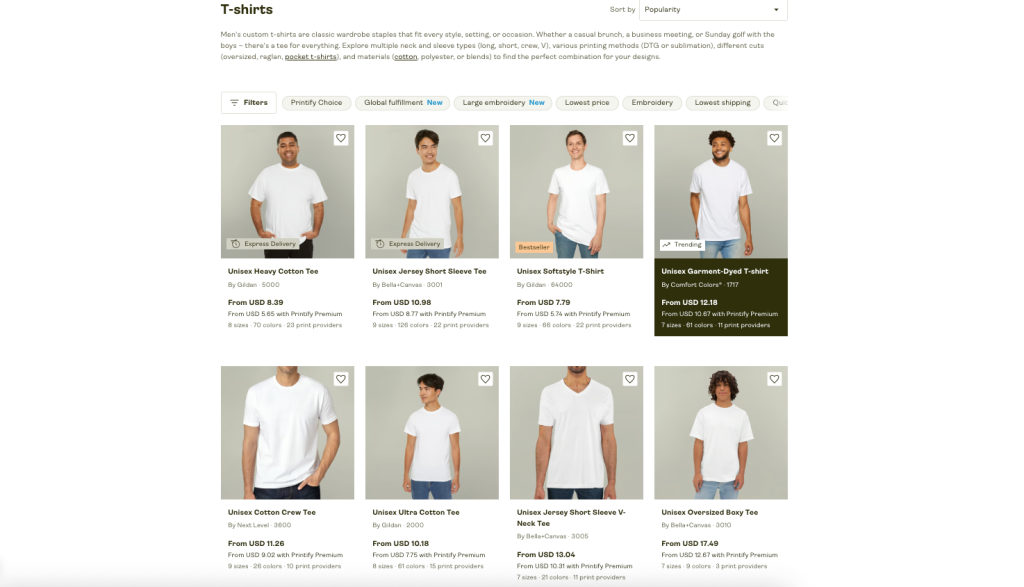
Printify offers hundreds of t-shirt options from trusted brands like Gildan, Bella + Canvas, and Next Level. You can filter by:
- Fabric type (cotton, tri-blend, polyester, etc.)
- Fit (unisex, women’s, oversized, relaxed)
- Price range
- Supplier location (for faster local shipping)
If your goal is to offer premium, long-lasting shirts, go for higher-end materials. If you’re testing a trend or targeting a budget audience, lightweight cotton tees are a great start.
Tip: Always match your t-shirt’s quality to your brand’s image. Customers can feel the difference, and higher-quality shirts often lead to repeat purchases.
Step 3: Upload and Customize Your Design
Once you’ve selected your shirt, it’s time to bring your creativity to life.
Using Printify’s Product Creator, you can easily:
- Upload your artwork or logo
- Adjust its placement on the shirt (front, back, sleeves, etc.)
- Preview the final product in real time
Printify supports multiple printing techniques, including Direct-to-Garment (DTG), embroidery, and all-over printing, so your designs can be as simple or detailed as you like.
Quick Tip: Always Order Samples
Before going live, order product samples to test print quality, fabric feel, and packaging.
Not only does this ensure quality control, but you can also use the sample for high-quality lifestyle photos, perfect for your website or social media promotions.
Step 4: Connect Printify to Your Online Store
Once your designs are ready, connect Printify to your preferred eCommerce platform.
Printify integrates seamlessly with major online marketplaces and store builders, including:
After integration, your custom t-shirt listings automatically sync between Printify and your store. That means whenever you create a new design in Printify, it appears instantly in your storefront, no manual uploads required.
Pro tip: Start with one platform first (like Shopify or Etsy), then expand to others once you see consistent sales.
Step 5: Publish, Promote Your Custom T-Shirts, and Let Printify Handle the Rest
Once your t-shirts are live, your main focus should shift to marketing and sales because Printify handles everything else for you.
Here’s how it works: every time a customer places an order, it’s automatically sent to one of Printify’s trusted print providers. From there, the shirt is printed, packaged, and shipped directly to your customer. You’ll even receive tracking updates without having to lift a finger.
No inventory to manage. No packing or shipping to worry about. It’s a fully automated system that lets your business grow as you keep adding new designs.
You can start small with just a few shirts and gradually expand into full collections of premium t-shirts, hoodies, and accessories, all while keeping your operation completely hands-free.
Bonus: How to Maximize Your Printify Custom T-Shirts Sales
To get the most out of Printify, follow these proven tips:
- Niche down: Target a specific audience (e.g., gym lovers, pet owners, travel enthusiasts).
- Use social media: Showcase your designs through Instagram Reels, TikTok videos, and Pinterest Pins.
- Offer limited drops: Create urgency with limited edition designs or seasonal collections.
- Bundle products: Sell matching mugs, hoodies, or tote bags to boost your average order value.
- Focus on storytelling: Share what inspired your designs to connect emotionally with your customers.
Why Printify Is Perfect for Beginners and Growing Brands
Printify isn’t just a printing platform. In fact, it’s a complete business ecosystem.
You get:
- Global printing partners
- Automatic fulfillment
- Affordable product pricing
- No upfront inventory risk
- A library of ready-to-sell product templates
Whether you’re launching your first online store or adding merch to your existing brand, Printify helps you scale effortlessly so you can focus on what really matters: building your brand and growing your profits.
Final Thoughts: Start Selling Custom T-Shirts with Printify
So, how much can you really make selling custom t-shirts online?
The honest answer is: it depends on you. Your earnings are shaped by the time you invest in designing, pricing strategically, and promoting your brand. But here’s the exciting part: t-shirts remain one of the most profitable and beginner-friendly products in eCommerce.
Why? Because everyone wears them. From casual basics to bold statement pieces, t-shirts are universal, and people love buying ones that feel personal, funny, or inspiring. That demand isn’t going away anytime soon.
With Printify, you can tap into that massive market without the traditional business risks. You don’t need to buy in bulk, manage warehouses, or guess which sizes will sell. Instead, you can focus entirely on your creativity and your customers.
Here’s why Printify makes it simple to start and easy to grow:
- No upfront investment: You only pay for each shirt after a customer buys it.
- No inventory stress: Every order is printed, packed, and shipped automatically by Printify’s global partners.
- Endless flexibility: Test new ideas, seasonal drops, and niche designs anytime with zero risk.
- No minimum order quantity: Start with one design and scale to thousands. Your cost structure stays the same.
In other words, Printify lets you turn creativity into income if you’re starting from scratch.
You design it, Printify prints and delivers it, and your customers enjoy a seamless experience. No upfront stock. No wasted cash. Just a clear, scalable way to grow your t-shirt business online.
So don’t wait for the “perfect time” to start.
The perfect time is now.
👉 Sign up for free with Printify and start selling your first custom t-shirt today. Your next big idea could be the design someone wears tomorrow.

